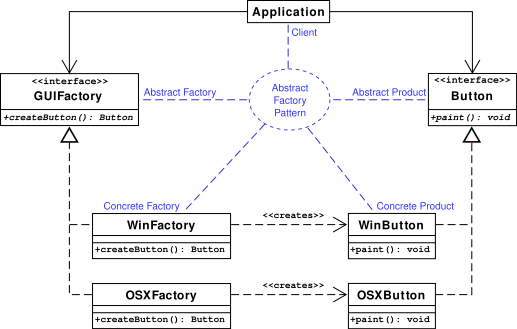Abstract Factory Pattern (추상 팩토리 패턴)
22 Jul 2019 | design pattern programming software추상 팩토리 패턴이란?
- 구체적인 클래스에 의존하지 않고 서로 연관되거나 의존적인 객체들의 조합을 만드는 인터페이스를 제공하는 패턴이다.
- 많은 수의 연관된 서브 클래스를 특정 그룹으로 묶어 한번에 교체할 수 있도록 만든 디자인 패턴이다.
추상 팩토리 패턴의 장단점
장점
- 인터페이스 보다는 구조체에 접근할 수 있는 코드를 제공한다.
- 확장에 매우 용이한 패턴으로 쉽게 다른 서브 클래스들을 확장할 수 있다.
- 기존 팩토리 패턴의 if-else 로직에서 벗어날 수 있게 해준다.
단점
-
새로운 종류의 제품을 제공하기 힘들다. AbstractProduct나 AbstractFactory에 새로운 항목을 추가해야 하는 경우가 생길수 있는데 이것은 인터페이스를 수정해야 한다.
-
객체를 만들때 객체지향 원칙인 LSP (Liskov Substitution principle) 를 해칠 수 있기 때문에 주의해야 한다.
UML 및 클래스 다이어그램



추상 팩토리 패턴을 사용하는 경우
대표적인 예로, OS에 따라 달라지는 GUI 변경과 같은 설정의 변경이 필요할 때 사용할 수 있다.
Sample
import java.util.Random; interface GUIFactory { Button createButton(); } class WinFactory implements GUIFactory { @Override public Button createButton() { return new WinButton(); } } class OSXFactory implements GUIFactory { @Override public Button createButton() { return new OSXButton(); } } interface Button { void paint(); } class WinButton implements Button { public void paint() { System.out.println("WinButton"); } } class OSXButton implements Button { public void paint() { System.out.println("OSXButton"); } } class Application { Application(GUIFactory factory) { Button button = factory.createButton(); button.paint(); } } public class Main { public static void main(String[] args) { int randomAppearance = new Random().nextInt(2); new Application(createOsSpecificFactory(randomAppearance)); } private static GUIFactory createOsSpecificFactory(int appearance) { switch (appearance) { case 0: return new OSXFactory(); case 1: return new WinFactory(); default: throw new IllegalArgumentException("unknown " + appearance); } } }
다른 패턴들과 비교
- factory 패턴과 다른 점은 factory를 좀 더 생산적으로 만들어 낼 수 있다는 점이다.
- 인풋에 대해 factory class 안에서 if-else로 다른 sub-class를 반환하는 일련의 과정을 생략할 수 있다.
팩토리 메서드 패턴과 너무 헷갈리는데, 뭐가 다를까?
팩토리 메서드 패턴과 팩토리 패턴의 차이 (StackOverflow) 많은 사람들이 헷갈려 하는 부분이고, 스택오버플로우에 잘 정리가 되어 있다.
팩토리 메서드 패턴
- 하나의 메소드이다
- 하나의 아이템을 만들기 위해 쓰인다
- 상속(Inheritance)을 사용하고 객체 생성을 핸들링하기 위하여 서브클래스에 의존한다.
class A { public void doSomething() { Foo f = makeFoo(); f.whatever(); } protected Foo makeFoo() { return new RegularFoo(); } } class B extends A { protected Foo makeFoo() { //subclass is overriding the factory method //to return something different return new SpecialFoo(); } }
추상 팩토리 패턴
- 객체이다
- 관련된 아이템들의 묶음을 만들기 위하여 만들어진다.
- 여러개의 팩토리 메소드를 가지고 있다.
- 객체 합성(Composition)을 통하여 객체 생성을 한다.
- 객체를 생성 가능한 객체를 만드는 추상 메소드를 가진 베이스 클래스를 만든다.
class A { private Factory factory; public A(Factory factory) { this.factory = factory; } public void doSomething() { //The concrete class of "f" depends on the concrete class //of the factory passed into the constructor. If you provide a //different factory, you get a different Foo object. Foo f = factory.makeFoo(); f.whatever(); } } interface Factory { Foo makeFoo(); Bar makeBar(); Aycufcn makeAmbiguousYetCommonlyUsedFakeClassName(); }
가장 큰 차이점은 각 패턴의 목적이 팩토리 메서드 패턴은 객체를 생성하는데 있지 않고, 추상 팩토리 패턴은 객체를 생성해야 한다는 것이다.
참고한 페이지
- 위키피디아
- https://yukariko.github.io/designpattern/2016/08/19/abstract-factory.html
- https://ko.wikipedia.org/wiki/%EC%B6%94%EC%83%81%ED%8C%A9%ED%86%A0%EB%A6%AC%ED%8C%A8%ED%84%B4
- https://donxu.tistory.com/entry/Abstract-Factory-Pattern%EC%B6%94%EC%83%81-%ED%8C%A9%ED%86%A0%EB%A6%AC-%ED%8C%A8%ED%84%B4
